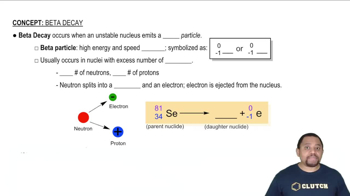Here are the essential concepts you must grasp in order to answer the question correctly.
Half-Life
Half-life is the time required for half of the radioactive nuclei in a sample to decay. For U-235, with a half-life of 703 million years, this means that after this period, only half of the original amount remains. Understanding half-life is crucial for calculating the remaining quantity of a radioactive substance over time.
Recommended video:
Exponential Decay
Exponential decay describes the process by which a quantity decreases at a rate proportional to its current value. In the context of radioactive decay, the amount of U-235 decreases exponentially over time, which can be mathematically represented by the equation N(t) = N0 * (1/2)^(t/T), where N0 is the initial amount, T is the half-life, and t is the elapsed time.
Recommended video:
Radioactive Decay Calculation
To determine how long it takes for a radioactive substance to reach a specific percentage of its initial amount, one can use the formula derived from the half-life concept. For U-235 to reach 10% of its initial amount, we can set up the equation N(t) = 0.1 * N0 and solve for t, using the known half-life to find the time required for this decay.
Recommended video:
Rate of Radioactive Decay
 Verified step by step guidance
Verified step by step guidance


